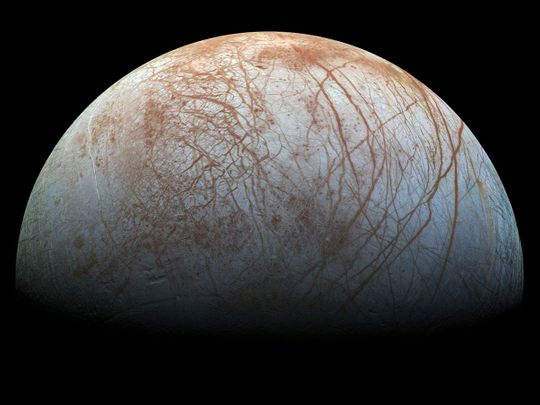
What does a nymph, who outsmarted Greek deities Zeus and Apollo, have to do with the planet Jupiter?
Click start to play today’s Crossword, which is all about Jupiter’s moons.
As the largest planet in the solar system, Jupiter has over 75 moons. Many of them are named after characters in Greek mythology, such as nymphs (7-Across) and deities (13-Down). But of all its moons, perhaps the most significant to us humans, is one of its largest – the Galilean moon called Europa.
The moon was first seen by Italian astronomer Galileo Galilei in 1609. On consecutive, cold December nights, he tracked the movement of three ‘stars’ swirling around Jupiter. But he noticed they weren’t behaving as he’d expected, and that they created strange patterns in the sky. After several months of observation, Galileo found another large ‘star’ joining the dance around Jupiter. In time, he realised he wasn’t viewing stars, but other planetary bodies, acting as satellites around the giant planet. He had discovered the largest of Jupiter’s moons: Io, Europa, Ganymede and Callisto.
Europa, which is the smallest of the lot, is 3,100km wide and resembles a massive ball of ice. But large patches of icy blocks and rust-red lines criss-cross its surface, in what scientists have termed “chaos terrain”. The red lines suggest geological fault lines lie underneath its frosty surface.
The moon is considered to be the most likely place to harbour life beyond the Earth. According to a September 2014 report published in the UK-based journal Nature Geoscience, Europa shares several Earth-like features, and is the only other body in the solar system that shows strong evidence for plate tectonic activity.
Observations of the moon’s magnetic field by US space agency National Aeronautics and Space Administration (Nasa) have also found that the moon’s icy crust envelopes an incredibly massive ocean. Europa’s body of water is so huge, it contains as much as three times the volume of liquid in all of Earth’s oceans! It’s here that scientists think incubation of extraterrestrial life is possible.
Europa’s chemical composition also shares commonalities with the Earth. For Europa to be habitable, it needs to have the essential building blocks for life – carbon, hydrogen, oxygen, and sulfur, among others. Scientists suspect that there may be enough chemical energy for microbial life on this Jovian moon.
It’s why the world’s space agencies are turning their focus to Europa next. The European Space Agency is eyeing a 2023 launch for its Jupiter Icy Moons Explorer mission, while Nasa’s Europa Clipper mission in 2024 aims to conduct a detailed reconnaissance of the moon.
Do you think Europa could harbour life? Play today’s Crossword and let us know at games@gulfnews.com.








